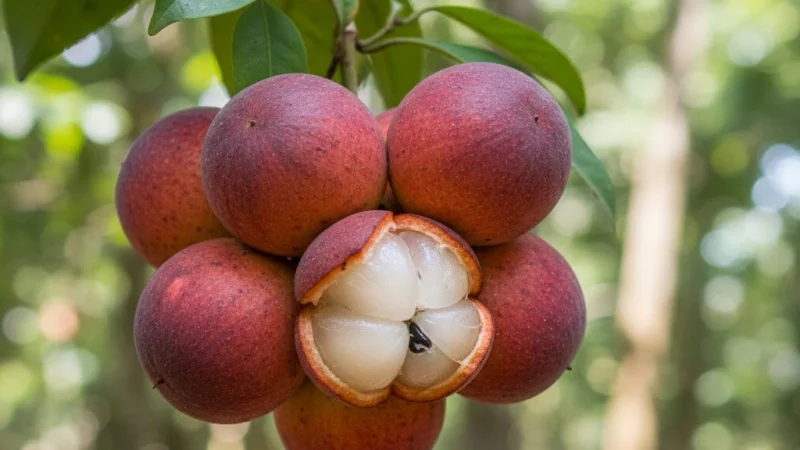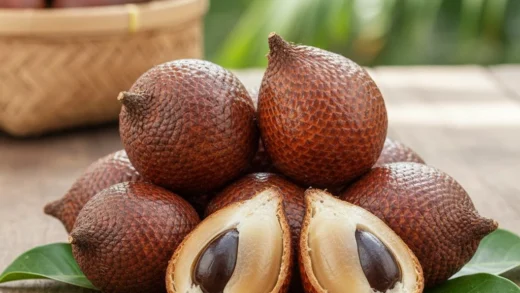Tampoi

Introduction
Tampoi stands as one of Malaysia’s most distinctive indigenous fruits, celebrated for its tangy-sweet complexity, striking colour, and deep cultural roots. Traditionally enjoyed in rural communities and rainforest regions, the fruit is now attracting renewed interest from chefs, agri-food innovators, and wellness-focused consumers. Its sensory appeal, coupled with its authentic heritage value, positions Tampoi as a strategic ingredient capable of bridging tradition with modern market expectations.
As global consumers gravitate toward natural, sustainably sourced tropical produce, Tampoi emerges as a premium contender—offering opportunities in artisanal desserts, innovative beverages, specialty products, and eco-tourism experiences.
Origin
Tampoi (Baccaurea macrocarpa) is native to Malaysia, Indonesia, and Brunei. The fruit thrives in lowland rainforests, shaded environments, and humid tropical climates. Part of the Phyllanthaceae family, Tampoi grows both wild and in smallholder village orchards.
Historically consumed by indigenous groups and forest communities, the fruit spread through traditional trade pathways and remains a regional specialty. While not yet cultivated on a commercial industrial scale, Tampoi continues to be agriculturally significant for biodiversity conservation, sustainable harvesting models, and community livelihoods.
Category
| Scientific Name | Family | Category | Type (Seasonality) |
|---|---|---|---|
| Baccaurea macrocarpa | Phyllanthaceae | Tropical Fruit | Seasonal (Dec–Feb) |
Appearance
Tampoi features a round to slightly oval shape with a diameter of approximately 4–7 cm. Its rind is thick, leathery, and brightly coloured—ranging from orange to deep reddish-orange when ripe. Inside, the fruit contains several segmented, translucent white pulps wrapped around large seeds. The visual contrast between its vivid shell and pale interior makes Tampoi highly recognizable and aesthetically appealing.
Popular Varieties
| Variety | Local Name | Distinctive Features | Region of Prominence |
|---|---|---|---|
| Baccaurea macrocarpa | Tampoi Merah | Deep orange skin, tangy flavour | Johor, Pahang |
| Baccaurea motleyana | Rambai | Yellow skin, sweeter taste, aromatic | Perak, Kedah |
| Baccaurea griffithii | Tampoi Acheh | Small size, higher acidity | Kelantan, Terengganu |
| Baccaurea dulcis | Tampoi Hutan | Reddish peel, balanced sweet-sour profile | Sabah, Sarawak |
Preparation
- Fresh consumption
- Snacks and preserved fruit
- Desserts including sorbets, jellies, and compotes
- Traditional dishes such as kerabu and sambal
- Beverages including juices, mocktails, and fruit blends
Equipment
- Paring knife
- Cutting board
- Fruit scoring tool
- Blender or food processor
- Airtight storage containers
Taste
Tampoi delivers a refreshing balance of tanginess and gentle sweetness. Its acidity resembles citrus, while its sweet undertones evoke notes of mangosteen and lychee. The flavour is bright, clean, and distinctly tropical, lending itself well to modern gastronomy and beverage development.
Texture
The pulp is soft, juicy, and slightly fibrous. Each segment provides a tender bite with a pleasant mouthfeel, making the fruit enjoyable both fresh and incorporated into soft-textured desserts.
Aroma
Tampoi has a light to medium aroma intensity with citrus-floral top notes. Its scent is refreshing, tropical, and subtly sweet without being overpowering.
Cultural Significance
Tampoi has long been part of Malaysian rural life, especially in communities bordering forest ecosystems. The fruit is commonly enjoyed during the harvest season and shared in family gatherings, village festivals, and open-air markets. It symbolises abundance, connection to nature, and the continuity of indigenous food heritage, making it an important cultural marker in regions across Peninsular Malaysia and Borneo.
Regional Cultivation
| State/Region | Famous For | Harvest Period |
|---|---|---|
| Johor | Large Tampoi Merah | Dec–Feb |
| Pahang | Forest-grown Tampoi | Dec–Jan |
| Sarawak | Diverse wild Tampoi species | Jan–Mar |
| Sabah | Mountainous wild varieties | Jan–Feb |
| Kelantan | Tampoi Acheh | Nov–Jan |
Social Context
Tampoi occupies a meaningful place in local social life. It is most often purchased from roadside stalls, weekly markets, or forest-fringe vendors during its seasonal peak. Families often enjoy it as a refreshing treat, while some use it as a palate cleanser after rich meals. Its arrival signals a short but eagerly awaited fruiting season, reinforcing community connections to local landscapes.
Nutritional Information (per 100g)
| Nutrient | Amount (Approx.) |
|---|---|
| Calories | 60–70 kcal |
| Carbohydrates | 15–18 g |
| Protein | 0.6–1 g |
| Fat | 0.5 g |
| Fiber | 2–3 g |
| Vitamins | Vitamin C, B-complex |
| Minerals | Potassium, Calcium, Iron |
Health Benefits
- Enhances immune strength with natural vitamin C
- Supports digestive health through dietary fiber
- Provides hydration with high water content
- Offers antioxidants that contribute to cellular protection
- Supplies natural sugars for sustained energy
Dietary Restrictions
- Should be consumed moderately by individuals sensitive to acidic fruits
- May impact those with gastric reflux or gastritis
- Requires mindful consumption for individuals managing blood sugar levels
- Not recommended for strict low-fructose diets
Allergens
- Rare cases of tropical fruit allergies may occur
- Possible mild reactions for individuals with latex-fruit syndrome
- Seeds must not be consumed
Cost
- Tampoi Merah: RM10–RM18 per kg
- Rambai / related varieties: RM8–RM15 per kg
- Wild Tampoi (Sabah/Sarawak): RM12–RM20 per kg
Prices fluctuate based on region, seasonality, and supply availability.
Production & Export
Tampoi remains predominantly a domestic fruit with limited export activity due to its short shelf life and seasonal availability. Smaller shipments reach niche markets in Singapore, Brunei, and certain Asian specialty grocers. Rising global appreciation for indigenous and exotic fruits presents future opportunities for Malaysia to introduce Tampoi into premium markets—particularly through value-added products such as juices, jams, frozen pulp, and artisanal confectionery.
Symbolism
Tampoi symbolises authenticity, abundance, and cultural lineage. Its seasonal nature reflects renewal, while its deep rural roots connect communities to Malaysia’s rainforest heritage. As interest grows in sustainable, identity-driven food products, Tampoi stands as a powerful representation of Malaysia’s natural wealth and culinary legacy.








Comments are closed.